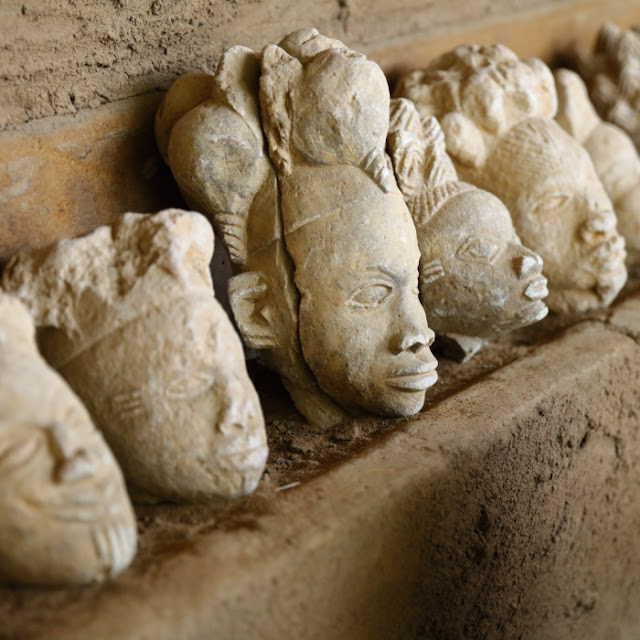 |
| turned into Stones |
Chief J. Agbo Ooye had been waiting in the shade of a large tree, in front of the National Museum of Esie, dressed in ceremonial costume with a velvet hat incrusted with crystal beads sown in the shape of his title and his name. He was sitting next to his wife on a bench, expecting our arrival. His wife, he would tell us later, was his best friend and she was actually demonstrating it by guiding his frail body from one place to another and guiding his hand when it came to sign autographs of his books. Chief Agbo Ooye is the author of two booklets on the Esie Stones. The first one, called A Personal Account of the Esie Stones is giving an overview of the differences between the scientific and the traditional interpretation of the Esie Stones. The second one is called the History of Esie and gives a brief account of Esie's history from the early settlement of Yorubas in various groups (Esie, Oro, Eku Apa, Igbonla, Edidi, Igbesi, etc...) to the present day. Those groups, who lived on respective pieces of land, broadly lived in peace and worshipped Yoruba gods in the same manner.
 |
| Chief Agbo Ooye talking about the Esie stones, next to his wife |
The Chief provided an insight into the discovery of the Esie stones, over a thousand pieces of them, that are on display at the National Museum of Esie. They are believed to have been discovered in a grove by the people of Esie in 1775. They were set in circle around a tree as if taking part into an audience to the local ruler who sat by the trunk of the tree.
The legend says that the ruler of Esie, the Elesie, ran away at the sight of the stone images. After consultation of the Ifa oracle, it was concluded that the stones where peaceful beings which could protect the protective spirit of Esie. It was also said that the Elesie should not be allowed to view the stones after the day of this coronation. Soon villagers added the stones images to the list of their gods, under the name of Ere, and a priest, called Aworo, would be dedicated to serve the stones. The Aworo would not be allowed to touch the stone images, he would only perform his worship rites and sacrifice by standing at the entrance of the grove. As is expected from some of the gods, the Ere were also thought to be able to make barren woman pregnant also help the start of the rainy season when it was late. At the beginning of the 20th century, a Westerner (Leo Frobenius) is said to have removed three heads from the statues. In the 1930s, a Christian man called Ramshaw started to raise awareness about the Stones so that they could be studied by archeologists and anthropologists.
 |
| varied profiles |
No one knows about the whereabouts of the stone images, however Chief Agbo Ooye was very vocal to defend the belief that the stones had been people turned into stones, in the sense that people beliefs were worth acknowledging as accepted truth in opposition to the scientific view of Westerners who would rationally try to look for clues that the stones were mere stone carvings. Essentially there is a traditional explanation to every Western clues that the stones would have been carved.
Asked about why so many heads were presented in the museum, Chief Agbo Ooye (who is Ooye Baba Oba, the King's father, or the persons who installs the new King on this throne) told us about a legend in which Awoko, the forest spirit was annoyed that the people of Esie sacrificed only one leopard in his honour, versus the five each sacrificed to Owo, Aasae and the stone images. Awoko revenged himself by beheading most of the stone images.
 |
| petrified for centuries |




7hubent Media WhatsApp TV is considered one of the top WhatsApp TV channels in Nigeria for advertising because of its large audience and high viewership. It has a daily audience of around 290,000 contacts. 7hubent's Instagram page also features memes on topics like comedy, fashion, relationships, and video.
ReplyDelete
ReplyDeleteThanks to 7hubent WhatsApp TV, our marketing strategy has been completely transformed. Their expertise in WhatsApp advertising has allowed us to reach more customers and boost our sales.
If you're in Nigeria and want to enhance your digital marketing, 7hubent is definitely worth considering
#WhatsAppMarketing #SalesTips #WhatsappTV #7hubent #grouplinks #whatsapp
#whatsapp_status #viral
#WhatsAppMarketing #Marketing
#whatsappgrouplinks
#DigitalMarketingNigeria
Join top WhatsApp TV channels group link chats in Nigeria 👇
https://medium.com/@7hubent/best-top-popular-whatsapp-tv-in-nigeria-is-7hubent-media-tv-channel-with-highest-views-update-174e11229ece
Sales and Marketing WhatsApp Group Link
Join here: 👇
https://www.7hubent.com.ng/2024/06/7hubent-whatsapp-tv-channel-and-group.html
Whatsapp marketing groups nigeria
Free whatsapp marketing groups
Digital Marketing WhatsApp Group link
Whatsapp marketing groups india
Marketing WhatsApp Group names
7hubent Media WhatsApp TV is considered one of the top WhatsApp TV channels in Nigeria for advertising due to its large audience and high viewership. It has a daily audience of around 290,000 contacts. 7hubent's Instagram page also features memes on topics like comedy, fashion, relationships, and video.
Affiliate Marketing WhatsApp Group Link
Digital marketing Group
Network Marketing WhatsApp Group
Agency WhatsApp group
WhatsApp groups for Advertising
Brand Ambassador WhatsApp Group